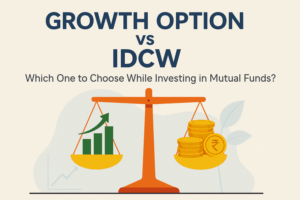SIP Calculator
×
How to choose mutual funds in India in 2025?

Indians, who had traditionally invested in bank deposits and gold, have embraced equity investments such as stocks and mutual funds wholeheartedly. Since direct stock investing is not for everyone, mutual funds have emerged as the top investment choice for millions of newbie retail investors. However, taking your pick from hundreds of mutual fund schemes can be a challenge. How do you choose mutual funds that are right for you?
The process of choosing the right mutual fund includes evaluating the fund on various criteria. Read on to learn more about how to choose mutual funds to build wealth in the long term.
Choosing mutual funds in India in 2025
Mutual funds are categorized based on the assets they invest in. Equity, debt, and hybrid are three popular categories of mutual funds available in the market today. Selecting a mutual fund for investment is a two-step process. First, you need to select the category you want to invest in and then find a scheme in your selected category.
Here are the factors you need to consider to narrow down your category selection and figure out a scheme in the category that matches your return expectations and your risk profile.
Investment objective
Defining your investment objective before looking for an investment alternative is imperative. Well-defined, clear investment objectives such as your kid’s education, planning for retirement, buying a house, financing your wedding, or going on a dream vacation will help you choose the mutual funds for SIP that match your investment goal.
Investment goals will vary from person to person and there is no right or wrong when defining your investment objectives. Your investment objectives need to be clear and quantifiable. This will help you choose the best-suited mutual fund scheme.
As a general rule of thumb, equity mutual funds are preferable for a long-term investment horizon of 5 years or above. Debt funds, on the other hand, are good for capital preservation and are hence useful for short-term investments.
“Start investing with confidence! Explore the best
mutual funds
and grow your wealth.”
Risk
Risk and return are two sides of the same coin. Therefore, it is very important to understand your risk appetite before investing. A significant criterion about how to select mutual funds for SIP is understanding the risks associated with the mutual fund scheme.
Equity mutual funds are subject to market fluctuations and thus, an equity-oriented fund could witness volatility in line with the market. Equity mutual funds pose a higher risk. But the returns can be substantially higher than other types of funds. This makes equity funds a good choice for long-term, aggressive investors.
Debt funds are relatively stable, making them a popular choice for conservative investors and short-term investments.
Here is a guide to mutual funds categories segmented by its risk-return profile.
| How to select mutual funds for SIP? | |||
| High Risk | Credit risk fundHybrid Funds | Multi Cap Funds | Mid Cap FundsSmall Cap Funds |
| Medium Risk | Low Duration fundsUltra Short Duration Funds | Balanced Advantage Funds | Multi Cap Funds |
| Low Risk | Overnight fundsLiquid Funds | Short Duration Funds, Gilt Funds | Large Cap Funds |
| Short Term(up to 3 years) | Medium Term\(3 to 5 years) | Long Term(5 years and above) | |
Liquidity
Liquidity is an important factor that should be considered before selecting a mutual fund.
If the investor knows he will need the money in a very short period, he can opt for debt funds as equity funds are volatile and might not provide the required returns in the short term. If the investment horizon is above a year, equity funds can be considered.
If the investment horizon is too short, that is anywhere between overnight to a few months, ultra-short-term liquid funds can be considered.
Investment strategy
Investment strategy is also referred to as investment approach. It is a strategy that the fund manager or the mutual fund house adopts to make all investment decisions. If your investment philosophy doesn’t align with the fund’s investment strategy, a conflict of interest will arise. This can lead you to exit the fund and a premature exit can incur exit load and reduce returns.
Fund performance
The past performance of the fund matters. Performance over 3 to 5 years should be considered before making an investment decision. The idea is to select a time frame that ensures that the fund has gone through multiple market cycles.
A good baseline for performance evaluation is to check if the fund has beat the benchmark returns over the selected timeframe.
While past performance is a good indicator, it is important to note that past performance does not guarantee future returns. Investors should evaluate the risk profile of the mutual fund before investing.
Expense ratio
Expense ratio is the fee charged by fund managers for professionally managing the mutual fund. It is the fund manager’s fee applicable to all mutual fund schemes in return for generating profits for investors.
The expense ratio will eat into your investment amount and therefore, you should target funds with a lower expense ratio.
Entry and Exit Load
Entry load is the fee charged by fund houses from investors. However, this has been eliminated by most fund houses.
Exit load is the fee charged when an investor exits the mutual fund scheme. Exit load is chargeable if investors exit the fund in a short period. It is levied by mutual fund houses to discourage quick exits that can lead to cash outflow from fund houses.
Investors should look for funds with minimum exit load. If a mutual fund has an exit load, short-term investments should not be made in those funds.
Taxes
Mutual fund returns are taxable as per the Income Tax Act. Equity mutual funds are taxed per their holding period.
Long-term capital gains tax (LTCG) will be applicable to mutual fund investments held for a year. The prevailing LTCG rate is 12.5%.
Short-term capital gains tax (STCG) will be applicable for mutual fund investments held for less than a year. The current STCG rate is 20%.
Debt mutual funds will be taxed at the investor’s tax slab.
Direct Plans
Two types of mutual fund investment plans are available to investors. Direct and regular mutual funds are different versions of the same plan.
In the case of direct investment, investors can directly buy required NAV units from a fund house. In the case of regular, the units have to be purchased through a broker or an agent.
A key difference between the two is that returns are slightly higher in a direct mutual fund as no commission expenses are incurred. The commission varies between 1-1.25%, depending upon the asset management company and brokerage firm.
A direct plan is better and thus investors should opt for it.
Conclusion
Mutual fund investments are subject to market risks. This is true, but as a mutual fund investor, you should first decide your investment objective and evaluate a scheme on the above-listed criteria before making an investment decision.
Disclaimer
The stocks mentioned in this article are not recommendations. Please conduct your own research and due diligence before investing. Investment in securities market are subject to market risks, read all the related documents carefully before investing. Please read the Risk Disclosure documents carefully before investing in Equity Shares, Derivatives, Mutual fund, and/or other instruments traded on the Stock Exchanges. As investments are subject to market risks and price fluctuation risk, there is no assurance or guarantee that the investment objectives shall be achieved. Lemonn (Formerly known as NU Investors Technologies Pvt. Ltd) do not guarantee any assured returns on any investments. Past performance of securities/instruments is not indicative of their future performance.







